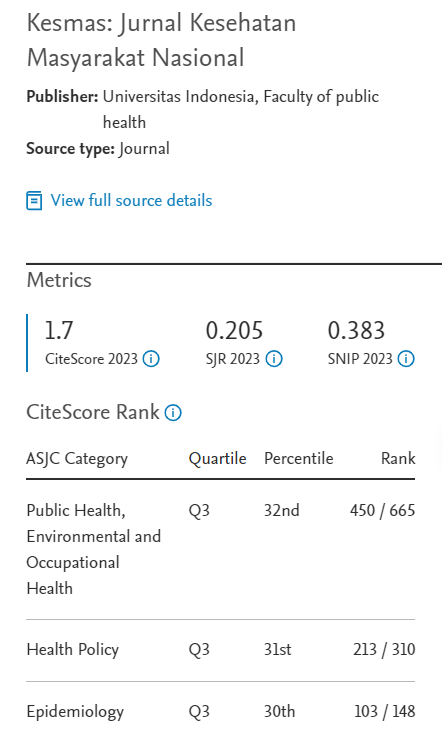Abstract
Penelitian tentang hubungan antara kadar timbel dalam darah dengan anemia yang tercermin dalam kadar hemoglobin dan hematokrit pada petugas pintu tol Jagorawi Jakarta. Landasan teori penelitian ini adalah hasil pemantauan kualitas udara Daerah Khusus Ibu Kota (DKI) Jakarta dimana kadar timbel di udara ambien melebihi Baku Mutu Lingkungan (BML) dan adanya petunjuk literatur bahwa timbel memiliki pengaruh negatif terhadap sistem hemopoitik pada manusia. Seratus orang pekerja terpilih untuk penelitian ini. Sebanyak 12% dari pekerja yang merupakan subjek pada penelitian ini tergolong anemia berdasarkan kadar hemoglobin darah dan 10% anemia berdasarkan nilai hematokrit. Kadar timbel darah yang didapatkan pada penelitian ini adalah 20,1 ± 1,1μgr% dengan maksimum 22,9μgr%; dengan kadar hemoglobin sebesar 15,2 ± 1,5gr% minimum 9,9gr%; nilai hematokrit sebesar 45,2 ± 4,4%, minimum 30%. Seluruh subjek memiliki nilai Pb darah di atas 10 μgr% termasuk 16 wanita dalam usia subur. Secara umum tidak ditemukan asosiasi yang bermakna antara kadar timbel darah terhadap kadar hemoglobin dan hematokrit. Asosiasi yang tidak bermakna antara kadar timbel darah terhadap kadar dan abnormalitas hemoglobin dan hematokrit bersesuaian dengan hasil studi peneliti lainnya yang menyatakan bahwa hubungan bersifat tidak bermakna pada kadar Pb darah di bawah 40 μgr%.
A study on the association of lead in blood and haemoglobin and hematocrit value as a measure of anaemia among toll booth workers at Jagorawi Jakarta, has been conducted. The rational of the study is that high aerial lead content has been reported by the Jakarta environmental authority and health literature indicates that lead is toxic to human hemopoeitic system. The toll booth workers are exposed to air pollutants in their day to day work. One hundred workers, randomly selected, participated in the study. On the haemoglobin concentration, 12% of the study subjects were categorized as anaemia, while on hematocrit values 10% were considered as anaemia. Blood lead concentrations found in this study were 20,1 ± 1,1 (mean ± SD) μgr% and the maximum value was 22,9μgr%. The haemoglobin values were 15,2 ± 1,5gr% with a minimum of 9,9gr%, while the hematocrit values were 45,2 ± 4,4% with a minimum of 30%. All blood lead values were above 10μgr% including 16 women of child-bearing age. In general, no association was found between blood lead and haemoglobin and hematocrit values. This discovery is in line with other studies which found that there is no meaningful association between blood lead and anaemia when the blood lead concentrations were below 40 μgr%.
References
- Sastrawijaya A, Tresna. Pencemaran lingkungan. Jakarta: PT Rineka Cipta; 2000.
- Chafid F, Kaharuddin, Mukhlison. Perhutanan kota. Yogyakarta: Fakultas Kehutanan Universitas Gadjah Mada; 2004.
- Patrick L. Lead toxicity: a literature review, alternative medicine review. 2006; 11 (1).
- Hamonangan E. Hasil pengukuran pb di udara ambien Kota Jakarta. Research Report JKPKBPPK. 2003.
- Suciani S. Kadar timbal dalam darah polisi lalu lintas dan hubungannya dengan kadar hemoglobin [tesis]. Semarang: Universitas Diponegoro; 2009.
- Achmadi UF. Analisis risiko efek pencemaran udara co dan pb terhadap penduduk Jakarta. Depok: Fakultas Kesehatan Masyarakat Universitas Indonesia; 1989.
- Goldstein DM, Kipen HM. Hematologic disorders in occupational health recognizing and preventing work related disease and injury. Barry SL, David HW, editors. Philadelphia: Lippincott Williams and Wilkins; 2000.
- Skerfving S. Criteria document for Swedish occupational standards: inorganic lead. Stockholm, Sweden: National Institute for Working Life; 2005.
- ACGIH. American conference of governmental industrial hygienist: tlvbooklet 2009. Cincinnati: ACGIH; 2010.
- Malaka T. Health risk assessment, theory, and application dalam kuliah pasca sarjana tentang K3-LH lanjut. Palembang: Sekolah Tinggi Ilmu Kesehatan Bina Husada; 2008.
- US-OSHA. Regulations (standards-29 CFR), respiratory protection. 1910,134. 2008 [diakses tanggal 4 Januari 2010]. Diunduh dari: http://www,osha,gov/pls/oshaweb/owadisp,show_document?p_id=127 16&p_table=standards.
- Berkow R, Fletcher AJ. Hematology and oncology (chapter 9). The Merck Manual. 16th ed. Rahway NJ: Merck Research Laboratory; 1992.
- Harbison RD. Lead (chapter 19). Hamilton and Hardy’s Industrial Toxicology. 5th ed. St Louis, Missouri: Mosby-Yearbook Inc; 1998.
Recommended Citation
Malaka T , Iryani M .
Hubungan Kadar Timbel dalam Darah dengan Kadar Hemoglobin dan Hematokrit pada Petugas Pintu Tol Jagorawi.
Kesmas.
2011;
6(1):
-
DOI: 10.21109/kesmas.v6i1.117
Available at:
https://scholarhub.ui.ac.id/kesmas/vol6/iss1/6








